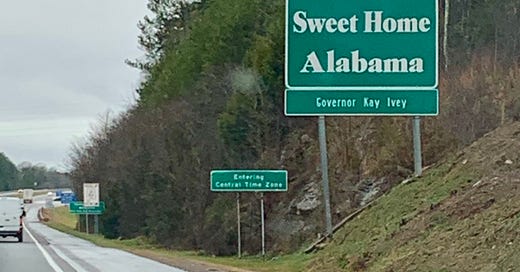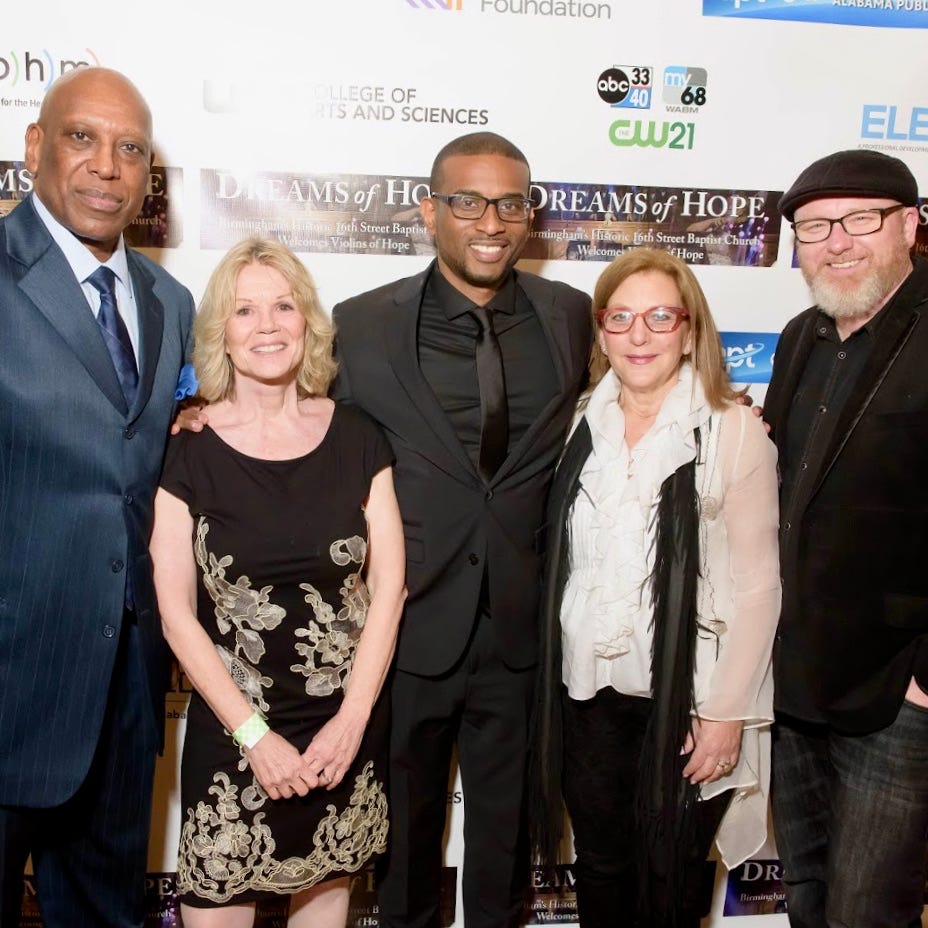Story Frame 77 – Sweet Home Alabama
Written by Douglas J. Eboch and directed by Andy Tennant, Sweet Home Alabama was a 2002 romantic comedy starring Reese Witherspoon. Eboch’s original story for the film was his master’s thesis while a student at the University of Southern California’s film school. The film takes its title from the 1974 song by the band, Lynyrd Skynyrd.
In February, Tom and I were on the highway, driving southwest from Asheville towards Birmingham, Alabama. You’re not likely to miss the moment when you cross over the state line from Tennessee – large green road signs welcome everyone to “Sweet Home Alabama.” That a state uses Lynyrd Skynyrd lyrics on their signs to welcome visitors was the first indication of interesting things to come.
While I was pleased to get an invitation to the film premiere of Dreams of Hope, a documentary I’d done the PBS station wrangling for, I still worried that a trip to Birmingham would make me sad, angry and upset, given America’s civil rights history.
Instead, my time in Birmingham was an inspiration.
We got into town early enough to explore the downtown area before the premiere. After checking into our hotel, we walked over to Linn Park, a quiet green space surrounded by interesting buildings, including the Birmingham’s Museum of Art and Jefferson County Courthouse. Designed by the Chicago Architectural film, Holabird & Root, the courthouse's Art Deco facade was so lovely, I whipped out my camera to take some photographs.
That attracted the attention of a large, burly white guard who came over and asked what I was doing. Knowing I was within my rights to take exterior shots without permission, I told him how much I admired the architecture.
“Want to see something really interesting?” he asked.
“Sure!” I said, having no idea what to expect but hoping his uniform meant he would do me no harm. He turned his back to me, waving an arm to follow him.
A short distance away, Tom watched the conversation unfolding, a little concerned. Seeing me follow the burly man inside the courthouse, he quickly caught up to us.
Inside, the guard proudly pointed to the large-scale painted murals on the lobby walls pained by John W Norton, WPA commissioned works of art contrasting the "Old South" to the "New South." They were astonishing. My grandfather, Perry Fellows, had been the Chief Engineer of the Works Progress Administration (WPA) between 1935 and 1947 during which time he was responsible for five thousand projects all over the country. So, I was always interested in seeing WPA projects. But the guard had something else in mind.
“Want to see something that’s not open to the public yet?” he asked.
What the hell could this be? I thought, nervously wondering if this could be a female entrapment situation. But by now, Tom was by my side, so I nodded yes, if Tom could come with me.
The guard smiled, then led us both over to an elevator with a sign on it that said it was closed to the public. Entranced by the beautiful Art Deco brass decorations around it, I stepped inside. The doors closed and the guard push the button for the 7th floor.
When the doors opened back up, we stepped out of the elevator – and into jail.
Specifically, the jail cell where Dr. Martin Luther King, Jr. had been held for an act of civil disobedience – parading without a permit. In a few months, the guard told us, it would be open to the public, but we were welcome to see the actual jail cell and take photographs of displays, including a telegram to King from boxing legend Muhammad Ali. He was clearly proud of it and enjoying showing off what Birmingham was doing to preserve its unique Civil Rights history.
Dreams of Hope featured a violin solo performed by Caitlin Edwards on one of the ‘Violins of Hope’ – musical instruments that belonged to Jews before and during the Holocaust and have since been lovingly restored by violin maker Amnon Weinstein and his son, Avshalom. In the heart and mind of Weinstein, these ‘Violins of Hope’ represent the victory of the human spirit over evil and hatred.
After seeing a Violins of Hope concert in another city, Birmingham resident Sallie Downs thought the violins could also bring hope to Birmingham if used in a concert to pay tribute to the American Civil Rights movement and the four African American girls killed by the 1963 Ku Klux Klan bombing of the 16th Street Baptist Church.
She pestered composer Henry Panion III, Director of Music Technology at the University of Alabama at Birmingham until he agreed to help her pull together the event. Best known for his work as conductor and arranger for his friend, Stevie Wonder, Henry has led many of the world’s most notable orchestras and was, in Sallie’s mind, the perfect person to create a unique piece of music for the Birmingham concert.
As excitement grew around the idea, filmmaker Mike Edwards was invited to weave together in documentary form the history of the violins, Henry’s composition and the concert at the 16th Street Baptist Church. The result was a celebration of the resilience of those who have faced hate, discrimination and racism.
Once the film was finished, I was hired to do the national PBS station wrangling for the documentary, which captured my heart with its story and Henry’s soaring music.
The Dreams of Hope premiere was held that evening at the Alabama Theater, a charming and unique 1920s combination of Spanish Colonial Revival and Mission Revival architecture and the sold-out crowd of nearly 2000 responded enthusiastically to the film.
It has has since been recognized with dozens of awards, including Los Angeles Film Awards, Spotlight Documentary Film Awards, New York Movie Awards and Near Nazareth International Film Festival, and the unprecedented feat of winning 13 Telly Awards.
From the food to the people to the art and architecture, as well as the spirit of the city itself, the trip to Birmingham was like a birthday party – a collection of great surprises just waiting to be opened up.
Although none of us could have known it at the time, the entire world was about to explode into the confusion and fears of a full-scale global pandemic. And we would need some dreams of hope ourselves in the coming days, months and years. With Zoë living and working on the west coast in Seattle, Leif at university in Finland, and me in the middle in Asheville, I sketched a cartoon in my head of me standing on top of one of the Blue Ridge Mountains. It was a sad and frightened little stick figure with impossibly long arms stretching in opposite directions, reaching out to try and hold them both.
Any amount boosts my spirits tremendously and helps get me one step closer to publication!
Coming up next: Story Frame 78 ~ Working From Wherever
Kristin Fellows is a published artisan writer, a world traveler, and a well-seasoned documentary film consultant. This tale comes to you from a small farming village in Portugal, where she is still surprised to find herself living.
When not writing, Kristin can often be found listening to someone’s story or behind the lens of one of her cameras.
More about Kristin @ kristinfellowswriter.com






